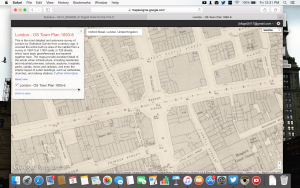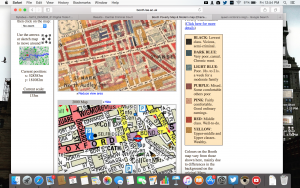This is Oxford Street, London. Picture from Google Maps

There is no doubt that Sherlock Holmes knows his way around Victorian London. In “The Adventure of Blue Carbuncle” Sherlock and his trusty companion, Watson, travel to the one of the market places that branch off of Oxford Street. Such market places were very common on Oxford Street during this era. Oxford Market was one of the largest markets on the street. This particular market attracted both rich and poor due to the merchandise it had to offer. Oxford Street according to records from the Charles Booth archive was predominately middle class (indicated by red on the map below.) However, areas surround the street had both upper class communities (yellow) and lower class dwellings (blue.) For this reason it is not surprising that the markets attracted various classes of society. 
With the poor and wealthy living so closely together it came to no surprise that the most common crime that occurred in this area was grand larceny/burglary/robbery/shoplifting. This is evident in “The Adventure of Blue Carbuncle” because the man’s goose was stolen, then was used as a disguise to carry a precious gem, which was also stolen. The accuracy of historical evidence/facts (discovered on the Old Bailey archive) alines with the crime within the fictional Sherlock Holmes stories. With some further digging, I found that such Geese sales were common (especially around Christmas, which is the time in which the adventure takes place) and that animal robbery became a large issue within this region. Other crimes of historical record that are also evident with the Holmes story is fraud, deception and gambling. This is seen with the man whom sells the geese at the market place. He will only give Holmes information regarding his stock and sales when Holmes places a bet for money. Holmes uses his own deception to trick the sales man into giving him information like what he assumes is true regarding the goose and it’s origin. Thus, the plot and story line make sense because it is historically accurate. Another clue to the conditions and characteristics of this area and salesman is the man’s poverty is displayed by the clothing that he wears. He is dressed very different from Holmes and Watson who are members of the upper/middle class. His lack of wealth could easily be seen as a reason for his actions and gambling nature.
The historical attributes of Oxford Street from the Victorian era is very important in the Holmes stories. By looking at the streets history it is easy to make connects to Sherlocks adventures and assume the background stories of the character that Holmes encounters in certain regions, such as the market place. Personally, this research has helped me further characterize certain individuals within the stories. It provides more insight as to why peoples actions (stealing, lying and deception) were as presented. The poor robbed from the rich because of their poverty and even robbed from each other; as seen with the robbery of the goose. This historical research has helped answer my questions as to why the incidents with the adventures of Sherlock Holmes may have taken place.
(Works cited, links within article to webpage)